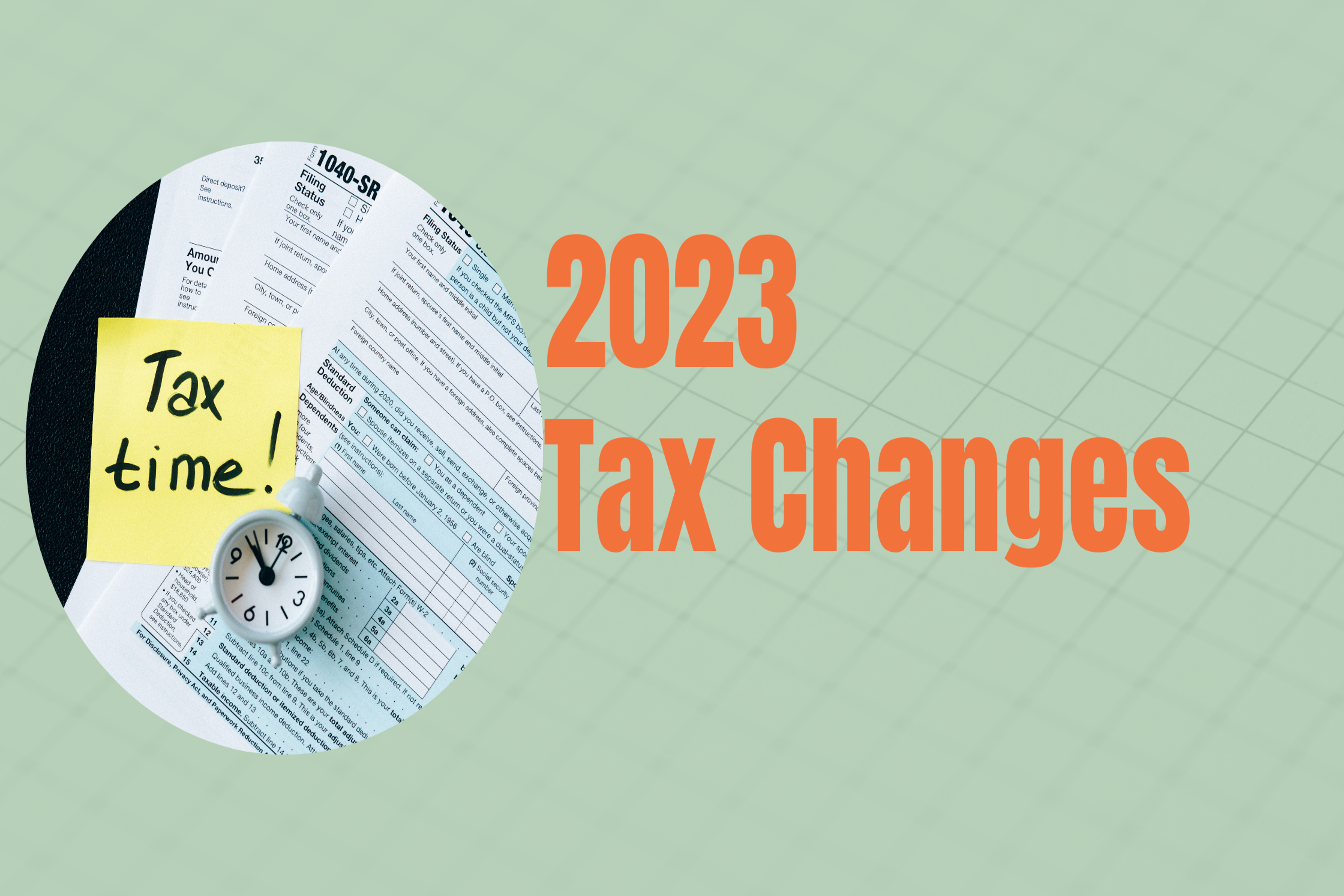
As we are approaching the new tax filing season, you may be wondering about the tax changes for the 2023 tax year. Whether you are an employee, a self-employed individual, or a retiree, these changes will affect your tax obligations and benefits for the 2023 tax year. In this blog post, we will summarize some of the key personal income tax changes that have been announced by the federal and provincial governments for the tax year 2023, and compare them to the previous year. The list of tax changes in this blog post is not definitive and is subject to change.
Here are some of the key personal income tax changes for the tax year 2023:
Basic Personal Amount (BPA): The BPA is a non-refundable tax credit that reduces the amount of federal tax you pay. For the year 2023, the BPA is $15,000, an increase of $602 from the previous year ($14,398).
Disability Amount: The Disability Tax Credit (DTC) is a non-refundable tax credit that can help Canadians with disabilities or their supporting persons reduce the amount of income tax they owe. The DTC amount for 2023 is $9,428, and those under 18 years of age may be eligible for a supplement of up to $5,500.
Age Amount: The Age amount is a non-refundable tax credit that can be claimed by Canadian taxpayers who were aged 65 or older on December 31 of the taxation year. The maximum amount that can be claimed in 2023 is $8,396, which is an increase from the previous year’s maximum of $8,171.
Registered Retirement Saving Plan (RRSP): The maximum contribution limit for Registered Retirement Savings Plan (RRSP) in Canada is set to increase to $31,560 for the year 2023, up from $30,780 in 2022.
Maximum Pensionable Earnings: For the year 2023, the maximum pensionable earnings amount under the Canada Pension Plan (CPP) is set to increase to $66,600 from $61,600 in 2022. The basic exemption amount for 2023 remains at $3,500. Starting in 2023, a higher, second earnings ceiling of $73,200 will be implemented and used to determine second additional or enhanced CPP contributions (CPP2). As a result, pensionable earnings between $66,600 and $73,200 will be subject to CPP2 contributions. You can read more about enhanced CPP contributions in our dedicated blog.
Maximum Employment Insurance (EI) Insurable Earnings: The maximum annual insurable earnings for Employment Insurance (EI) in Canada is set to increase to $63,200 for the year 2023, up from $61,500 in 2022.
Canada Child Benefit (CCB): The maximum annual CCB benefit for a child under the age of 6 will increase to $7,437 in 2023 from $6,997 in 2022. For those aged 6 through 17, the maximum annual benefit will increase to $6,275 in 2023 from $5,903 in 2022.
Child Disability Benefit: The maximum CDB benefit for a child under the age of 18 will increase to $3,173 in 2023 from $3,122 in 2022. For the period of July 2023 to June 2024, a qualified individual can get up to $3,322 for each child who is eligible for the disability tax credit.
Medical Expenses Tax Credit (METC): For the 2023 tax year, the maximum amount that can be claimed for the METC is the lesser of 3% of net income or $2,635. For the 2022 tax year, the maximum amount that can be claimed for the METC is the lesser of 3% of net income or $2,479.
Old Age Security (OAS) Recovery Limits: If your net world income exceeds $86,912 in 2023 ($81,761 in 2022), you may have to repay part or the entire Old Age Security (OAS) pension. The OAS pension recovery tax is calculated based on the difference between your net world income and the minimum income recovery threshold for the year. If the difference is greater than zero, you will have to repay 15% of that amount as a monthly recovery tax.
Old Age Security (OAS) Recovery Limits: If your net world income exceeds $86,912 in 2023 ($81,761 in 2022), you may have to repay part or the entire Old Age Security (OAS) pension. The OAS pension recovery tax is calculated based on the difference between your net world income and the minimum income recovery threshold for the year. If the difference is greater than zero, you will have to repay 15% of that amount as a monthly recovery tax.
Home Office Expenses Due to COVID-19: For the 2023 tax year, the deduction for home office expenses due to the COVID-19 has been eliminated and is no longer claimable. In contrast, during the 2022 tax year, individuals had two methods available to claim home office expenses: the Temporary Flat Rate Method (Simplified) and the Detailed Method. The simplified method allowed a straightforward claim of $2 per day worked from home, up to a maximum of $500. The detailed method required separating and documenting actual expenses related to the home workspace.
Federal Income Tax Bracket - The following table illustrates the 2023 tax brackets in comparison to 2022 and their corresponding taxable income thresholds:
| 2023 | 2024 | |
| Taxable income above which the 20.5% bracket begin | $53,359 | $50,197 |
| Taxable income above which the 26% bracket begins | $106,717 | $100,392 |
| Taxable income above which the 29% bracket begins | $165,430 | $155,625 |
| Taxable income above which the 33% bracket begins | $235,675 | $221,708 |
The Multigenerational Home Renovation Tax Credit (MHRTC) – MHRTC is a new refundable credit introduced in the 2022 budget by the Canadian government to assist with the cost of renovating an eligible dwelling to establish a “Secondary Unit” that enables a qualifying individual (a senior or an adult who is eligible for the disability tax credit) to live with a qualifying relation. The credit is available for qualifying expenditures made or incurred after December 31, 2022, for services performed or goods acquired after that date. The maximum amount of the refundable credit is $7,500 which is calculated at 15% of maximum renovation expenses of $50,000.
Canada Caregiver Credit: For the 2023 tax year, if you have a dependant younger than 18 who’s physically or mentally impaired, you may be able to claim up to an additional $2,499 in Canada Caregiver tax credits. For infirm dependants 18 or older, the amount for 2023 is $7,999.
Lifetime Advanced Life Deferred Annuity (ALDA) Dollar Limit: ALDA is a retirement income option that allows Canadians to defer a portion of their retirement savings until they turn 85. The amount that an individual can purchase is subject to a lifetime dollar limit of $150,000 (indexed to inflation) and a lifetime limit of 25% of any particular qualifying plan. The Lifetime ALDA dollar limit for the 2023 tax year is $160,000. For the 2024 tax year, the Lifetime ALDA dollar limit for 2022 was $150,000.
Home Buyers’ Amount: Home Buyers’ Amount is a non-refundable tax credit that can be claimed by Canadian taxpayers who bought a qualifying home. For the year 2023, you can claim up to $10,000 for the purchase of a qualifying home and get a non-refundable tax credit of up to $1,500. The amount is unchanged from the 2022 tax year.
Prescribed Rate for Loans to Family Members: The prescribed rate is the minimum interest rate that the CRA considers acceptable for tax purposes when a loan is made between family members. If you lend money to a family member and charge an interest rate that is at least equal to the CRA’s prescribed rate, the interest income you receive will be taxed at your family member’s lower tax rate. The rate is revised quarterly. The prescribed rate on loans to family members was 5% in Q4 2023 and is set to increase to 6% in Q1 2024.
Prescribed Rate for Overdue Taxes: The interest rate Canadians must pay on overdue tax was 5% for individuals and 9% for corporations in Q4 2023. For the first quarter of 2024, the interest rate for overdue taxes will be 10%. It is important to note that interest on overdue taxes is calculated daily and compounded daily.
Tax-Free Savings Account (TFSA): The Tax-Free Savings Account (TFSA) is a registered account that allows Canadians to earn tax-free investment income. The annual contribution limit for 2023 is $6,500, an increase of $500 from the previous year. To put this in perspective if someone who has been eligible since the introduction of the TFSA in 2009 would have a total of $88,000 in contribution room available for 2023.
First Home Savings Account (FHSA): FHSA is a registered plan that allows eligible individuals to contribute up to $40,000 for their first home with tax-free withdrawals. It combines the tax advantages of the registered retirement savings plan (RRSP) and the tax-free savings account (TFSA). Similar to RRSP, the FHSA offers several benefits, including reducing your taxable income with tax-deductible contributions, paying no taxes on any investment earnings within the account, carrying forward any unused contribution room or unused (undeducted) contributions indefinitely, transferring any contributions that have not been used to purchase a home, to an RRSP account on a tax-free basis, assuming the individual has remaining RRSP contribution to absorb the surplus. Annual contributions to an FHSA account are capped at $8,000 annually in addition to the lifetime contribution limit of $40,000.
Residential Property Flipping Rules - Under the new rule, profits from the sale of a flipped property are deemed to be business income. Where the new deeming rule applies, profits on the sale cannot be treated as a capital gain (50-per-cent income inclusion) and the Principal Residence Exemption is not available if the property is sold within 365 consecutive days from the date of purchase. This is a change from the previous years, when an individual could sell a residential property that was held for personal use or to generate rental income and treat the profits as capital gains. If the property was the “principal residence” of the homeowner, the owner could claim the principal residence exemption to eliminate any tax arising from the gain. Any losses from the sale of a flipped property are deemed to be nil - meaning it may not be used to reduce the taxable income of the individual taxpayer.
GST/HST Implications of Consignment Sales - Under the current GST/HST rules, an assignment sale made by a person that their newly constructed or substantially renovated residential housing is not or not intending to be their principal residence is generally taxable. An assignment sale made by an individual may be either taxable or exempt, depending on the purpose of the original agreement of purchase and sale. Any amount an assignor paid as a deposit to a builder is included in the consideration for a taxable assignment sale. Under the new ruling all assignment sales, including those made by individuals, in respect of newly constructed or substantially renovated residential housing are taxable for GST/HST purposes. The rule excludes any amount attributable to a deposit paid by an assignor to a builder from the consideration for a taxable assignment sale, when certain conditions are met. The proposed amendment would apply to all assignment agreements entered into after May 6, 2022.
2023 Filing Deadlines - The 2023 return and payments are due on or before the following dates:
For further information please contact Taxtron Support at 416-491-0333 or visit www.taxtron.ca
Posted on 12 January 2024


